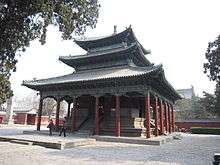Qing shui Temple
The Qing Shui Temple is a temple located on Lotus Lake in Taiwan.

History
The temple was built in 1787.[1] The temple is also known as the Divine Progenitors Temple, an allusion to the seven images of Divine Progenitors that were brought here by immigrants from Anxi. Of the seven, the Penglai Divine Progenitor, also called the "Nose Dropping Divine Progenitor", is considered the most powerful. According to local mythology, the nose of the image fell off to warn his followers of imminent danger. After the calamity had passed, the nose would assume its original position once again.
This temple worships Master Qing Shui, a national hero who fought against the Yuan army and helped resume the Sung Dynasty. His job included the management of awards for good deeds and punishment for evil deeds in the domains of Yin and Yang. He saved the souls of thousands of people. Whatever they requested, the Master must give them. His kindness knew no bounds, and the fruits he brought were numerous. The temple is situated at the East and faces to the West. Lotus Lake is in front of the temple. Its right hand side lays Panping Mountain, and its left hand side is Great and Small Tortoise Mountains. The construction of the temple is a mixture of the characteristics of the Eastern and Western construction. The structure is magnificent and the impressive style is dignified and solemn. The statue of the intelligent and courageous master garrisoned the village at then trance. It is height of 50 feet, length of 30 feet and width of 28 feet. It was inlaid by 387 units of Hunglung stones. The wooden carved traditional palace lanterns hung at the main temple has an impressive dignified and solemn air. The celestial dragons, lighting lamps, net walls, arches, relief in sculptures, tablets, and net windows are all carved in Chinese cypress with its true color remained. The door gods made of sunflower pear solemn. The sculptors of Tungyang of Chechiang Province especially came here to do the carving and inlaying work. The round columns and walls inside the temple adopt natural milky white fossils matched with wood sculptures. It set up both of elevators and staircases are facing each other; it’s safe and convenient.
Architecture
Qingshui Temple has had a long and wonderful history when it comes to its architecture. Even in the entrance this is evident when one looks at the pair of giant dragon pillars. Either side of the temple's outer wall bear carvings dating back to the late 18th century and early 19th century. These carvings are the oldest artwork in the temple. Other structures like the beams, walls, and dragon pillars carry inscriptions from the Qing Dynasty. It is features like these that have earned the Qingshui Temple the reputation of being the best example of mid-Qing temple architecture in Taiwan.

References
- ↑ "Taipei Qingshui Temple". Tourism Bureau, Republic of China (Taiwan). Retrieved 2 February 2013.